The 25 news outlets analyzed in this study emphasized a varying mix of topics during President Joe Biden’s first 60 days in office, and they differed dramatically in terms of the balance of positive and negative assessments they provided. Outlets with right-leaning audiences, in particular, stood out in these respects.
At the same time, these media outlets similarly framed their stories much more around Biden and his administration’s policy agenda than on leadership and character, a sharp break from the pattern observed in the early days of Donald Trump’s administration.
Roadmap to Part 1 of this report

Part 1 of this study examines news coverage of the first 60 days of the Biden administration across 25 news outlets. These outlets are grouped into three categories based on the ideological leaning of their audiences: outlets with audiences that lean to the right, outlets with audiences that lean to the left and those with audiences that are more mixed ideologically. (See Appendix A for more details about these groupings.) Categorizing media outlets in this way can show how coverage differs by media type, particularly since Americans’ news choices often align with their political leanings.
Five topics dominated early coverage of Biden administration
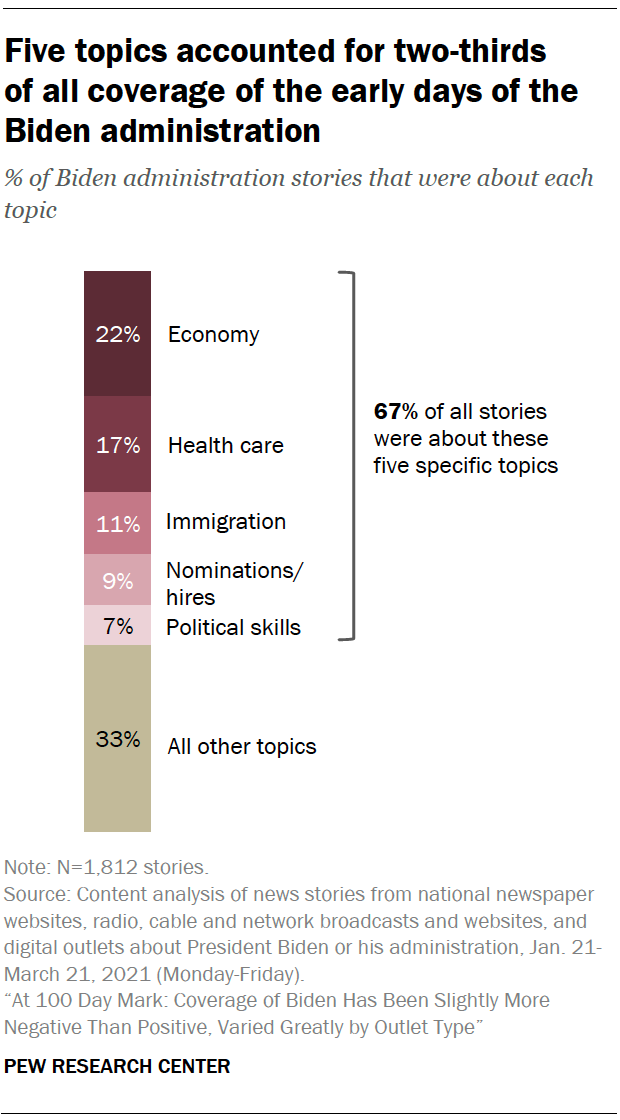 Across the 25 news outlets included in this study, five topics accounted for two-thirds (67%) of all coverage in Biden’s first 60 days. Stories about the economy ranked highest, making up 22% of all stories studied, followed closely by health care news at 17%.
Across the 25 news outlets included in this study, five topics accounted for two-thirds (67%) of all coverage in Biden’s first 60 days. Stories about the economy ranked highest, making up 22% of all stories studied, followed closely by health care news at 17%.
Both the economy and health care were major areas of focus in the early days of the administration: Biden signed a $1.9 trillion economic stimulus bill into law on March 11, while the federal government ramped up efforts to distribute COVID-19 vaccines. These two initiatives, as well as several others, were deeply intertwined with the COVID-19 pandemic. Because of that intense overlap, story references to COVID-19 were also measured separately – measuring whether COVID-19 was a major or minor part of the story – and are discussed in detail below.
The next most frequently covered topic was immigration (11% of all stories studied during this period), which gained attention as migrant apprehensions at the U.S.-Mexico border surged.
Biden’s appointments, nominations and hires accounted for 9% of all stories studied, reflecting weeks of Senate action on his appointees ranging from Secretary of Defense Lloyd Austin, who was confirmed in late January, to Secretary of Health and Human Services Xavier Becerra, who was confirmed in mid-March.
Stories discussing the political skills of Biden and his administration made up 7% of all stories (a topic area that broadly encompasses their level of expertise, strategy and management). All other individual topics accounted for 5% or fewer of media stories in the administration’s first 60 days.
News outlets with right-leaning audiences stood out for their focus on immigration
 The emphasis of news coverage during the early days of the Biden administration differed somewhat across news outlets based on the ideological leaning of their audiences.
The emphasis of news coverage during the early days of the Biden administration differed somewhat across news outlets based on the ideological leaning of their audiences.
Outlets with left-leaning audiences and those with more mixed audiences both focused heavily on the economy and health care during Biden’s first 60 days in office. These two topic areas accounted for just under half (45%) of all stories from outlets with left-leaning audiences and 39% of stories from outlets with mixed audiences. Outlets with right-leaning audiences, by contrast, put more emphasis on the issue of immigration, which ranked first at 20% of news stories. The economy and health care came in among the next for this group at 14% and 13% respectively.
COVID-19 was a major part of early coverage across a number of topic areas
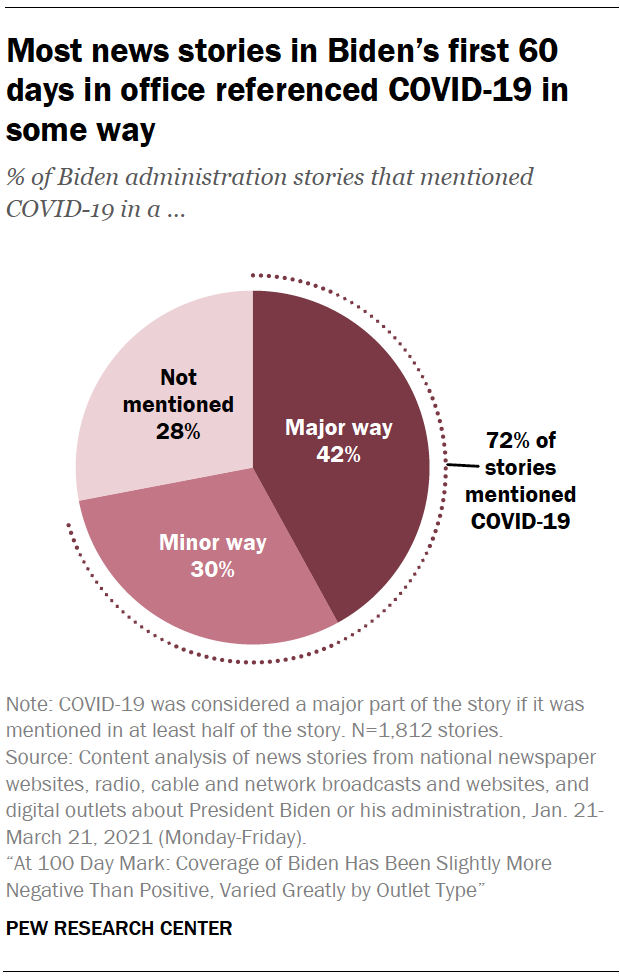 COVID-19 was a pervasive part of the media narrative of Biden’s first 60 days in office, cutting across a wide range of topic areas, especially the economy and health care. As such, references to the pandemic were measured separately from topic.
COVID-19 was a pervasive part of the media narrative of Biden’s first 60 days in office, cutting across a wide range of topic areas, especially the economy and health care. As such, references to the pandemic were measured separately from topic.
Overall, 72% of all stories about the Biden administration’s early days mentioned COVID-19 in some way. It was a major part of the reporting – meaning at least half the story was focused on it – in 42% of all stories and a minor part of the reporting in another 30%.
COVID-19 most frequently came up in media coverage related to health care and the economy. Nearly every health care story analyzed in this study referenced the coronavirus in some way, with a large majority of these stories including it as a major element of the reporting. The vast majority of stories about the economy (96%) also mentioned the virus, with 79% focusing on it in a major way. COVID-19 came up in 80% of stories about Biden’s political skills and management and 64% of immigration stories, usually only in a minor way – i.e., in less than half of the story.
The pandemic was mentioned less frequently in news stories about Biden’s presidential nominees: 42% of these stories mentioned COVID-19, usually in a minor way.
 Outlets with left-leaning and ideologically mixed audiences were most likely to mention the coronavirus in their reporting. Three-quarters of all stories from outlets with left-leaning audiences (75%) mentioned COVID-19, including 45% in which it was a major focus. Outlets with more mixed audiences referenced the virus in 72% of stories, including 44% in which it was a major focus. Outlets with right-leaning audiences were less likely to mention the virus, though 63% of stories from these sources still did so, including 29% in which the coronavirus was a major focus.
Outlets with left-leaning and ideologically mixed audiences were most likely to mention the coronavirus in their reporting. Three-quarters of all stories from outlets with left-leaning audiences (75%) mentioned COVID-19, including 45% in which it was a major focus. Outlets with more mixed audiences referenced the virus in 72% of stories, including 44% in which it was a major focus. Outlets with right-leaning audiences were less likely to mention the virus, though 63% of stories from these sources still did so, including 29% in which the coronavirus was a major focus.
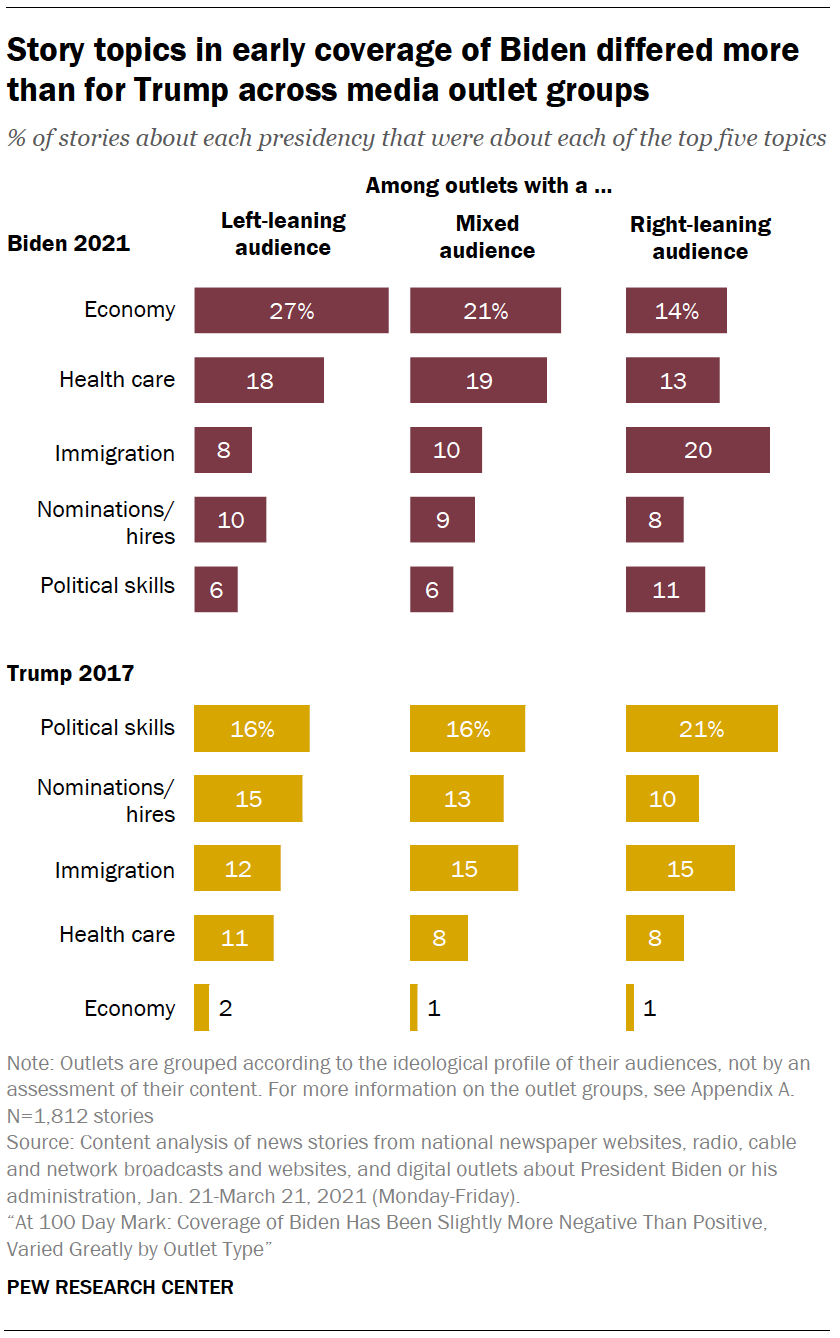 The topics that make the news at the outset of one administration can differ from those in another administration, but there are some recurring themes in 2021 and 2017.1
The topics that make the news at the outset of one administration can differ from those in another administration, but there are some recurring themes in 2021 and 2017.1
Four of the top five topics covered during the early days of the Biden administration also made the top five in the Trump administration’s first days: political skills, immigration, nominations and hires, and health care. The exception was the topic of the economy, which was the most frequently covered subject during the Biden administration’s early days but not among the top topics for Trump. Conversely, U.S.-Russia relations were among the top subjects covered in Trump’s early days but not among those for Biden.2
Another difference worth noting: While the president’s political skills was among the most frequently covered topics in the early days of the Trump administration (17% of stories), it was the focus of a much smaller share of stories about Biden’s early days in office (7%).
Perhaps more noteworthy is the greater degree of difference among the three types of outlets this year when compared with the first 100 days of the Trump administration. In a 2017 analysis, all three types of outlets devoted comparable attention to a similar mix of topics. In 2021, outlets with right-leaning audiences stood out in their heavier focus on immigration.
Assessments of Biden’s early days in office were slightly more negative than positive, but far more positive than coverage of Trump’s early days
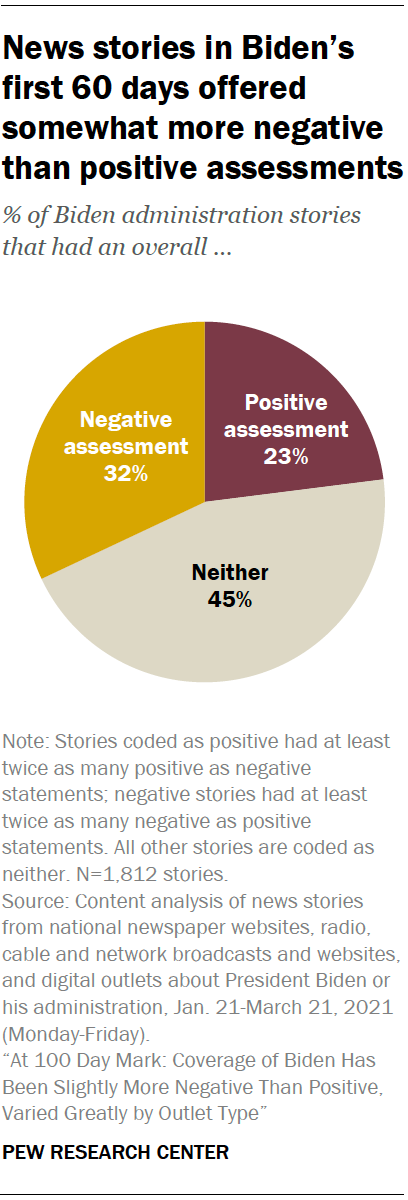 The statements made by sources in a story – as well as the words used by reporters – can determine whether it offers a positive assessment, a negative assessment or neither. In this study, Center researchers analyzed each statement made by the reporter and sources cited in a story to determine how, if at all, it assessed the words or actions of Biden and his administration. Stories were considered positive if they had at least twice as many positive as negative statements; they were considered negative if the reverse was true. If neither threshold was met, researchers coded stories as neither positive nor negative. (It is important to note that deeming stories positive or negative does not mean they are biased or inaccurate, but rather that the mix of comments ended up offering a positive or negative sense of what occurred. Read more about the methodology here.)
The statements made by sources in a story – as well as the words used by reporters – can determine whether it offers a positive assessment, a negative assessment or neither. In this study, Center researchers analyzed each statement made by the reporter and sources cited in a story to determine how, if at all, it assessed the words or actions of Biden and his administration. Stories were considered positive if they had at least twice as many positive as negative statements; they were considered negative if the reverse was true. If neither threshold was met, researchers coded stories as neither positive nor negative. (It is important to note that deeming stories positive or negative does not mean they are biased or inaccurate, but rather that the mix of comments ended up offering a positive or negative sense of what occurred. Read more about the methodology here.)
During the first 60 days of the Biden presidency, news stories were slightly more likely to carry a negative assessment than a positive one, though stories more often ended up largely balanced in their assessment. Overall, roughly one-third of stories (32%) had a negative assessment of the actions of the Biden administration, compared with 23% that had a positive assessment. Just under half of the stories (45%) offered neither a negative nor a positive assessment.
Outlets with right-leaning audiences stood out for their negative assessment of the Biden administration’s early actions
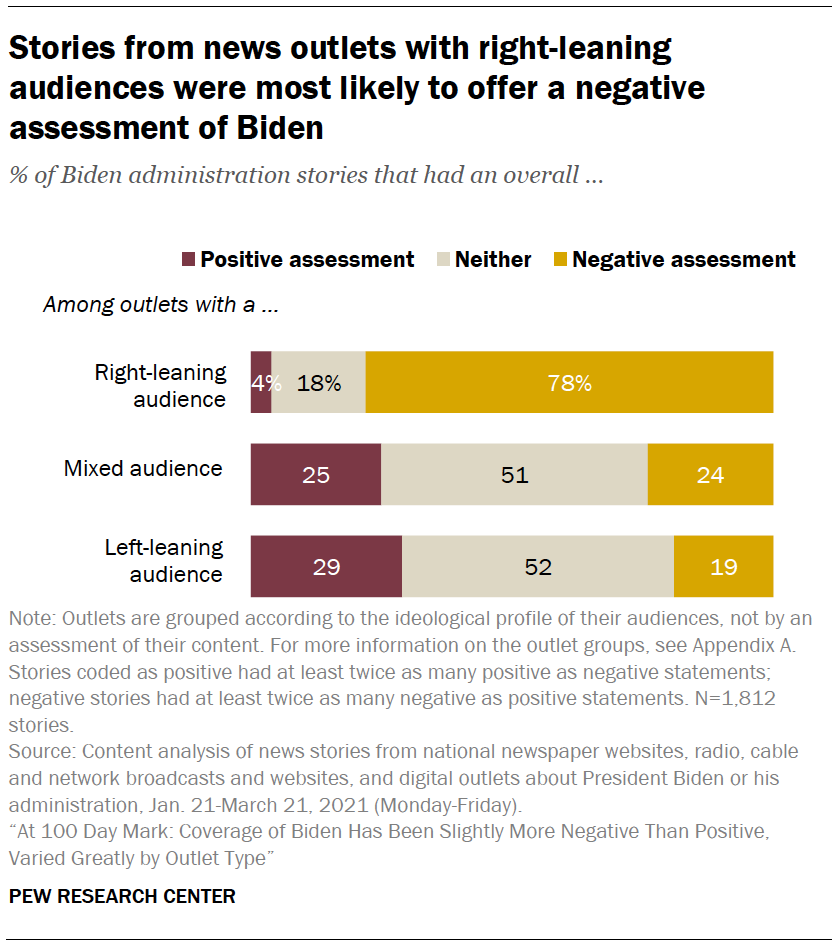
Assessments of Biden and his administration differed dramatically between outlets with right-leaning audiences and those with left-leaning or ideologically mixed audiences.
About eight-in-ten stories from outlets with right-leaning audiences (78%) offered a negative assessment of the actions of Biden or his administration. Just 4% offered a positive assessment, while 18% were neither positive nor negative.
News stories produced by outlets with left-leaning audiences, by contrast, were more likely to offer a positive than negative assessment (29% vs. 19%). Outlets with mixed audiences offered roughly equal portions of positive and negative assessments (25% vs. 24%). For both the left and mixed outlet groups, about half all assessments were neither positive nor negative.
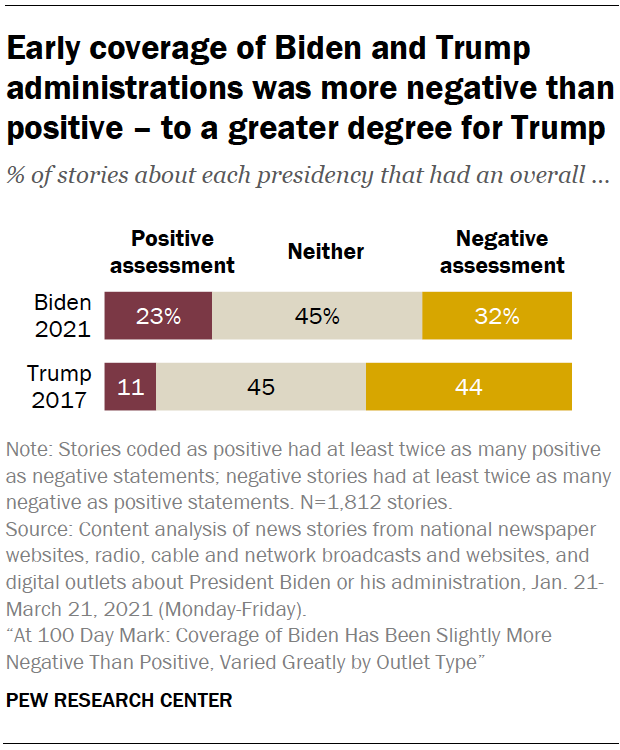 News assessments of the Biden administration’s early days differed substantially from those in the early days of the Trump administration – both overall and by media outlet type.
News assessments of the Biden administration’s early days differed substantially from those in the early days of the Trump administration – both overall and by media outlet type.
Stories about Trump’s first 100 days in office were four times as likely to be negative as positive (44% vs. 11% respectively).3 For both Biden and Trump, however, just under half of all assessments were neither positive nor negative.
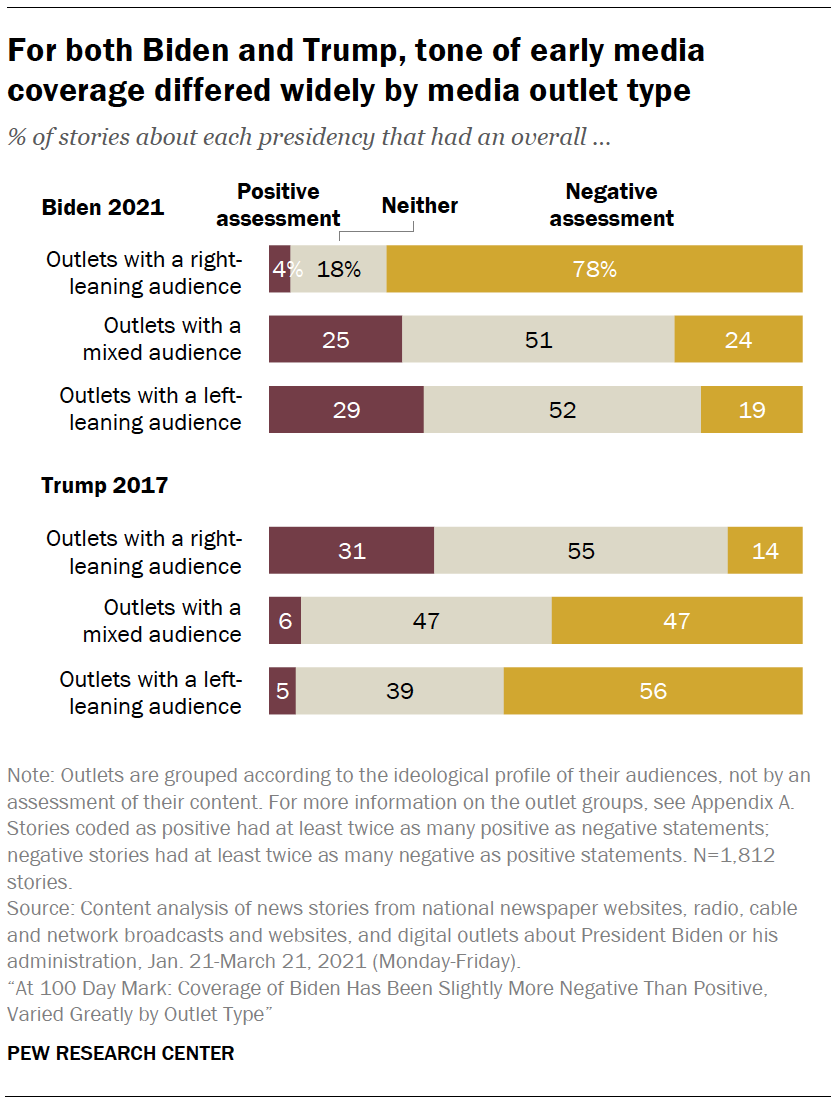 In 2017, outlets with right-leaning audiences were far more positive than negative in their assessment of Trump’s early days. Stories produced by these outlets were about twice as likely to offer a positive than negative assessment of the Trump administration (31% vs. 14%), even though 55% were neither positive nor negative. By contrast, stories produced by news outlets with left-leaning or ideologically mixed audiences were far more likely to offer a negative than positive assessment of Trump’s early actions.
In 2017, outlets with right-leaning audiences were far more positive than negative in their assessment of Trump’s early days. Stories produced by these outlets were about twice as likely to offer a positive than negative assessment of the Trump administration (31% vs. 14%), even though 55% were neither positive nor negative. By contrast, stories produced by news outlets with left-leaning or ideologically mixed audiences were far more likely to offer a negative than positive assessment of Trump’s early actions.
Early coverage of Biden administration much more focused on policy agenda than leadership skills and character
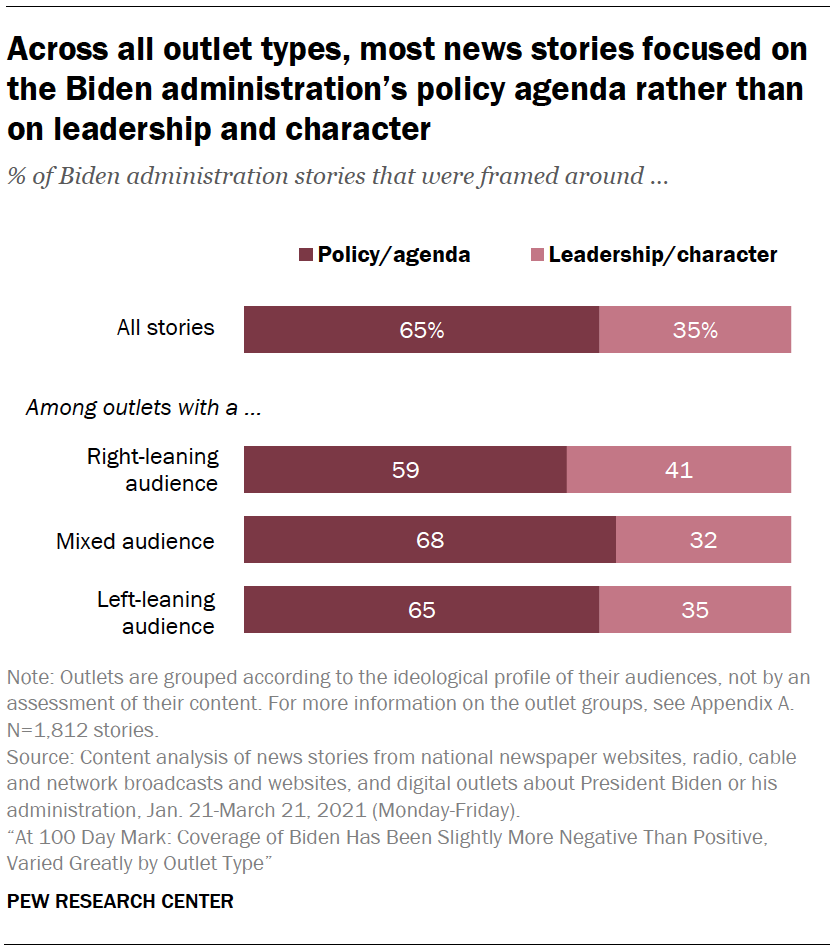 When reporting a story about a specific topic, journalists can use various frames to orient the narrative. This study classifies stories into one of two main frames (whichever accounted for more than 50% of the story): the president’s leadership and character, or his policy and agenda. In the first 60 days of the Biden administration, all three media outlet groupings were much more likely to frame their stories around the president’s policy agenda than his character and leadership skills.
When reporting a story about a specific topic, journalists can use various frames to orient the narrative. This study classifies stories into one of two main frames (whichever accounted for more than 50% of the story): the president’s leadership and character, or his policy and agenda. In the first 60 days of the Biden administration, all three media outlet groupings were much more likely to frame their stories around the president’s policy agenda than his character and leadership skills.
Overall, roughly two-thirds of the stories (65%) were framed around Biden’s policy agenda. That included majorities of stories from all three media groups, with right-leaning outlets the least likely to do so, at 59%.
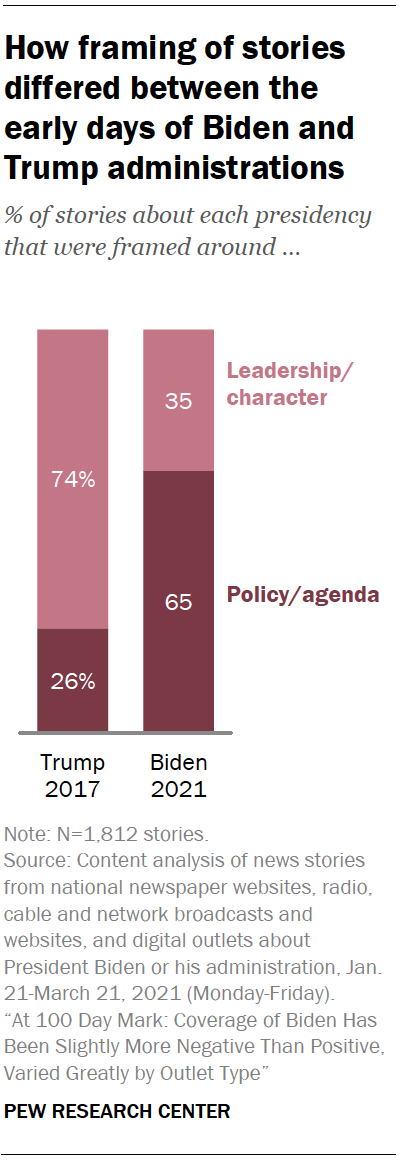 The framing used by the news media in 2021 stands in contrast to the framing used during the early days of the Trump administration in 2017. Four years ago, around three-quarters of stories about the new Trump administration (74%) were framed around the president’s leadership and character, with very little difference among media groupings.
The framing used by the news media in 2021 stands in contrast to the framing used during the early days of the Trump administration in 2017. Four years ago, around three-quarters of stories about the new Trump administration (74%) were framed around the president’s leadership and character, with very little difference among media groupings.
Assessment of the Biden administration varied by topic being addressed
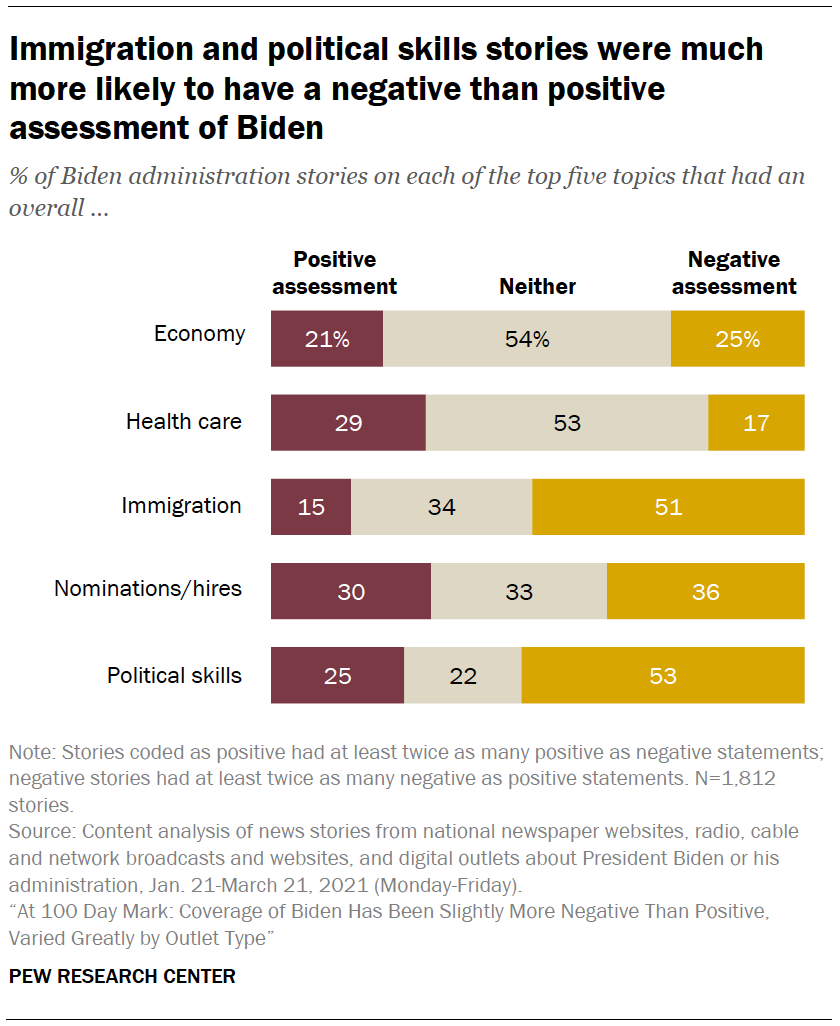 The media’s assessment of the Biden administration’s first 60 days didn’t just vary by the type of outlet doing the reporting. It also varied based on the topic area being addressed, as well as whether the framing of the story was around the Biden administration’s policy agenda or leadership and character.
The media’s assessment of the Biden administration’s first 60 days didn’t just vary by the type of outlet doing the reporting. It also varied based on the topic area being addressed, as well as whether the framing of the story was around the Biden administration’s policy agenda or leadership and character.
Stories that addressed Biden’s political skills and management and his administration’s efforts on immigration were much more likely to offer negative than positive assessments. Roughly half of stories about Biden’s management and political skills (53%) had a negative assessment, while 25% had a positive assessment and 22% had neither. When it came to the administration’s efforts on immigration, 51% of stories had a negative assessment and 15% had a positive assessment, while 34% offered neither a positive nor a negative assessment.
Out of the five most commonly covered topic areas in Biden’s first 60 days, the one that saw more positive than negative assessments was health care (29% positive, 17% negative, 53% neither positive nor negative). Stories about the economy most likely had neither a positive nor a negative assessment and were about as likely to have a negative (25%) as a positive assessment (21%).
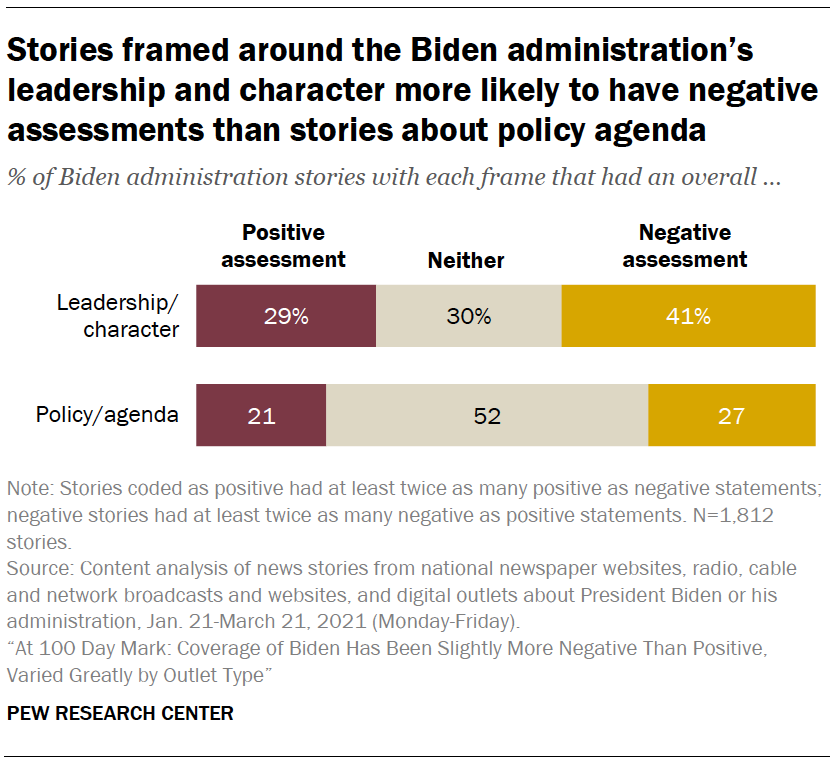 While the media’s overall coverage of the Biden administration’s early days focused much more on the president’s policy agenda than his leadership skills and character, negative assessments were more common in stories that focused on the latter.
While the media’s overall coverage of the Biden administration’s early days focused much more on the president’s policy agenda than his leadership skills and character, negative assessments were more common in stories that focused on the latter.
Stories framed around Biden’s policy agenda mainly were neither positive nor negative: 52% fell into this category, while 21% had positive assessments and 27% had negative assessments. Stories framed around Biden’s leadership skills and character, on the other hand, were far more negative than positive (41% vs. 29%, with the remainder neither).


